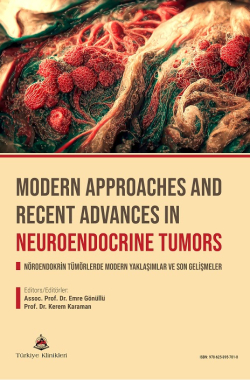GASTROENTEROPANCREATIC NEUROENDOCRINE TUMORS: EPIDEMIOLOGIC AND CLINICAL FEATURES
Sercan Ön
Tepecik Training and Research Hospital, Department of Medical Oncology, İzmir, Türkiye
Ön S. Gastroenteropancreatic Neuroendocrine Tumors: Epidemiologic and Clinical Features. In: Gönüllü E, Karaman K, editors. Modern Approaches and Recent Advances in Neuroendocrine Tumors. 1st ed. Ankara: Türkiye Klinikleri; 2025. p.9-14.
ABSTRACT
Gastroenteropancreatic neuroendocrine tumors (GEP-NETs) are relatively rare. Their frequency has been increasing over time. These tumors are typically diagnosed in older patients and can originate from the tubular gastrointestinal system or the pancreas. The ileum is the most common site of origin, followed by the rectum, appendix, colon, and stomach. The exact etiology remains unclear, but they can be associated with inherited syndromes such as multiple endocrine neoplasia type 1 (MEN1). Tumor location affects the clinical course and tumor behavior. GEP-NETs are heterogeneous, with the risk of metastasis, bioactive amine synthesis capacity, and prognosis varying significantly. GEP-NETs are graded according to Ki-67 and mitotic index, with clinical progression becoming more aggressive as the tumor grade increases. While it is difficult to describe common characteristics for such a heterogeneous group of tumors, the liver is the most frequent site of metastasis. Due to the release of bioactive amines from tumor cells, GEP-NETs can lead to carcinoid syndrome. Functional pancreatic neuroendocrine tumors secrete various hormones such as insulin, gastrin, and glucagon, resulting in unique clinical manifestations.
Keywords: Gastroenteropancreatic neuroendocrine tumor; Carcinoid tumors; Malignant carcinoid syndrome; Epidemiology; Neoplasm metastasis
Kaynak Göster
Referanslar
- Yao JC, Hassan M, Phan A, et al. One hundred years after "carcinoid": epidemiology of and prognostic factors for neuroendocrine tumors in 35,825 cases in the United States. J Clin Oncol. 2008;26(18):3063-3072. [Crossref] [PubMed]
- Surveillance, Epidemiology, ve End Results (SEER) Program. SEER*Stat Data base: Incidence-SEER Research DataCounties, National Cancer Institute, DCCPS, Surveillance Research Program, released April 2021, based on the January 2025 submis sion. Available at cancer.gov [Link]
- Lloyd RV, Osamura RY, Klöppel G, et al. eds. WC of T, of Endocrine Organs. 2th ed. Lyon FIA for R, 2017. on C. No Title.
- Niederle MB, Hackl M, Kaserer K, Niederle B. Gastroenteropancreatic neuroendocrine tumours: the current incidence and staging based on the WHO and European Neuroendocrine Tumour Society classification: an analysis based on prospectively collected parameters. Endocr Relat Cancer. 2010;17(4):909-918. [Crossref] [PubMed]
- Metz DC, Jensen RT. Gastrointestinal neuroendocrine tumors: pancreatic endocrine tumors. Gastroenterology. 2008;135(5):1469-1492. [Crossref] [PubMed] [PMC]
- WHO Classification of Tumours Online. Access time: 01/02/2025.
- Chu QD, Hill HC, Douglass HO, et al. Predictive factors associated with long-term survival in patients with neuroendocrine tumors of the pancreas. Ann Surg Oncol. 2002;9(9):855-862. [Crossref] [PubMed]
- Strosberg J, Gardner N, Kvols L. Survival and prognostic factor analysis in patients with metastatic pancreatic endocrine carcinomas. Pancreas. 2009;38(3):255-258. [Crossref] [PubMed]
- Modlin IM, Kidd M, Latich I, Zikusoka MN, Shapiro MD. Current status of gastrointestinal carcinoids. Gastroenterology. 2005;128(6):1717-1751. [Crossref] [PubMed]
- von der Ohe MR, Camilleri M, Kvols LK, Thomforde GM. Motor dysfunction of the small bowel and colon in patients with the carcinoid syndrome and diarrhea. N Engl J Med. 1993;329(15):1073-1078. [Crossref] [PubMed]
- Maton PN. The carcinoid syndrome. JAMA. 1988;260(11):1602-1605. [Crossref] [PubMed]
- Borch K, Ahrén B, Ahlman H, Falkmer S, Granérus G, Grimelius L. Gastric carcinoids: biologic behavior and prognosis after differentiated treatment in relation to type. Ann Surg. 2005;242(1):64-73. [Crossref] [PubMed] [PMC]
- Soga J. Early-stage carcinoids of the gastrointestinal tract: an analysis of 1914 reported cases. Cancer. 2005;103(8):15871595. [Crossref] [PubMed]
- Modlin IM, Champaneria MC, Chan AKC, Kidd M. A three-decade analysis of 3,911 small intestinal neuroendocrine tumors: the rapid pace of no progress. Am J Gastro enterol. 2007;102(7):1464-1473. [Crossref] [PubMed]
- Burke AP, Thomas RM, Elsayed AM, Sobin LH. Carcinoids of the jejunum and ileum: an immunohistochemical and clinicopathologic study of 167 cases. Cancer. 1997;79(6):10861093. [Crossref]
- Nesti C, Bräutigam K, Benavent M, et al. Hemicolectomy versus appendectomy for patients with appendiceal neuroendocrine tumours 1-2 cm in size: a retrospective, Europe-wide, pooled cohort study. Lancet Oncol. 2023;24(2):187-194. [Crossref] [PubMed]
- Ballantyne GH, Savoca PE, Flannery JT, Ahlman MH, Modlin IM. Incidence and mortality of carcinoids of the colon. Data from the Connecticut Tumor Registry. Cancer. 1992;69(10):2400-2405. [Crossref] [PubMed]
- Caplin M, Sundin A, Nillson O, et al. ENETS Consensus Guidelines for the management of patients with digestive neuroendocrine neoplasms: colorectal neuroendocrine neoplasms. Neuroendocrinology. 2012;95(2):88-97. [Crossref] [PubMed]
- Nomura N, Fujii T, Kanazumi N, et al. Nonfunctioning neuroendocrine pancreatic tumors: our experience and management. J Hepatobiliary Pancreat Surg. 2009;16(5):639-647. [Crossref] [PubMed]
- Madura JA, Cummings OW, Wiebke EA, Broadie TA, Goulet RL, Howard TJ. Nonfunctioning islet cell tumors of the pancreas: a difficult diagnosis but one worth the effort. Am Surg. 1997;63(7):573-577; discussion 577-8.
- Cheslyn-Curtis S, Sitaram V, Williamson RC. Management of non-functioning neuroendocrine tumours of the pancreas. Br J Surg. 1993;80(5):625-627. [Crossref] [PubMed]
- Zerbi A, Falconi M, Rindi G, et al. Clinicopathological features of pancreatic endocrine tumors: a prospective multicenter study in Italy of 297 sporadic cases. Am J Gastroenterol. 2010;105(6):1421-1429. [Crossref] [PubMed]
- Service FJ, McMahon MM, O'Brien PC, Ballard DJ. Functioning insulinoma--incidence, recurrence, and longterm survival of patients: a 60-year study. Mayo Clin Proc. 1991;66(7):711-719. [Crossref] [PubMed]
- Brennan MD, Service FJ, Carpenter AM, Rubenstein AH, Edis AJ. Diagnosis of pancreatic islet hyperplasia causing hypoglycemia in a patient with portacaval anastomosis. Am J Med. 1980;68(6):941-948. [Crossref] [PubMed]

